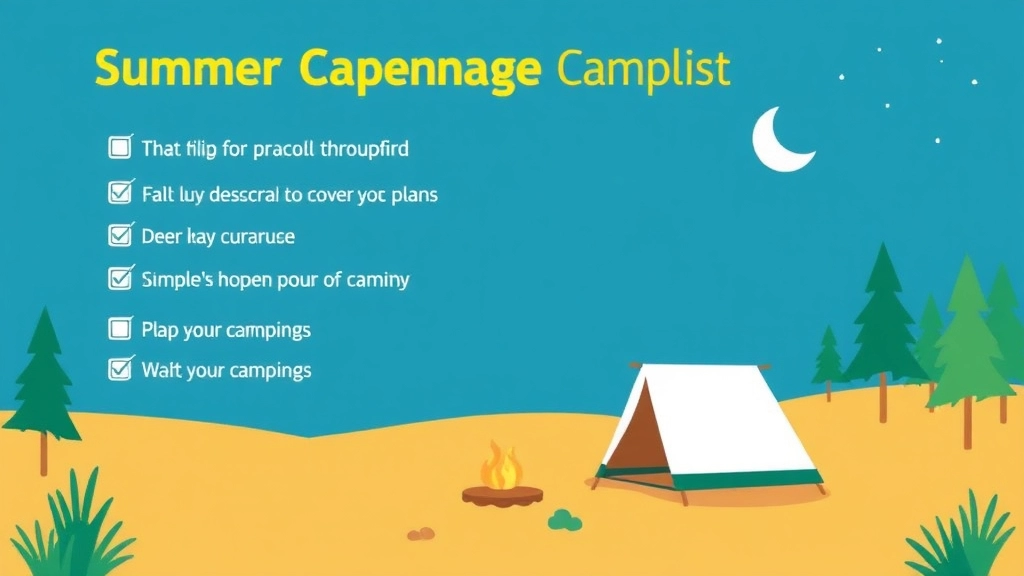Planning a Summer Camping Trip?
You’re in the right place! This article is your ultimate guide to a hassle-free, enjoyable camping experience. From essential camping gear and must-have sleeping items to cooking equipment and food storage tips, we’ve got you covered. We’ll also dive into sun protection and summer apparel, tools for camp setup and repairs, and first aid and emergency kits. Plus, we’ll explore outdoor entertainment gear, water and hydration supplies, and how to navigate bug-heavy campsites with insect repellents and nets.
What to Expect
But that’s not all! We’ll also discuss optional comfort add-ons like furniture and lighting, hygiene and clean-up products for the campsite, and planning for varying summer weather conditions. Whether you’re a seasoned camper or a newbie, our comprehensive summer camping checklist ensures you won’t miss a thing.
Get Ready for the Great Outdoors!
So, pack smart, stay comfortable, and get ready to enjoy the great outdoors like never before!
Essential Camping Gear for Summer
Alright, let’s dive into the nitty-gritty of what you really need for a successful summer camping trip. If you’ve ever wondered, âWhat gear is absolutely essential for summer camping?â or âHow do I make sure I’m not forgetting anything crucial?â you’re in the right place. We’ve all been there, stressing over missing something important. So, let’s cut through the noise and get straight to the point.
Must-Have Summer Camping Gear
When it comes to summer camping, there are a few pieces of gear you just can’t do without. Here’s a rundown:
- Tent: This is your home away from home. Make sure it’s lightweight, easy to set up, and has good ventilation. Summer nights can be warm, and you’ll want a tent that breathes.
- Sleeping Bag: Opt for a sleeping bag that’s rated for warmer temperatures. You don’t want to be sweating bullets in a bag designed for winter.
- Sleeping Pad: Comfort is key. A good sleeping pad will not only make your nights more comfortable but also offer some insulation from the ground.
- Backpack: A sturdy, comfortable backpack is essential for carrying all your gear. Look for one with multiple compartments to keep things organised.
Real-Life Example
Imagine this: You’re setting up camp after a long hike. You pull out your tent, and it’s a breeze to set up. You slide into your lightweight sleeping bag, and the sleeping pad makes you feel like you’re on a cloud. No fuss, no stress. That’s the kind of experience we’re aiming for here.
Quick Tips for Choosing the Right Gear
- Ventilation: For tents and sleeping bags, ventilation is crucial. Look for mesh panels and breathable materials.
- Weight: Summer camping often involves a lot of hiking. Lightweight gear will make your life a lot easier.
- Durability: Summer storms can be unpredictable. Make sure your gear can withstand a bit of rough weather.
Internal Links for Further Reading
By focusing on these essentials, you’ll be well on your way to a hassle-free, enjoyable summer camping experience. Trust me, getting the right gear makes all the difference. So, pack smart, stay comfortable, and enjoy the great outdoors.
Must-Have Sleeping Items for Comfort
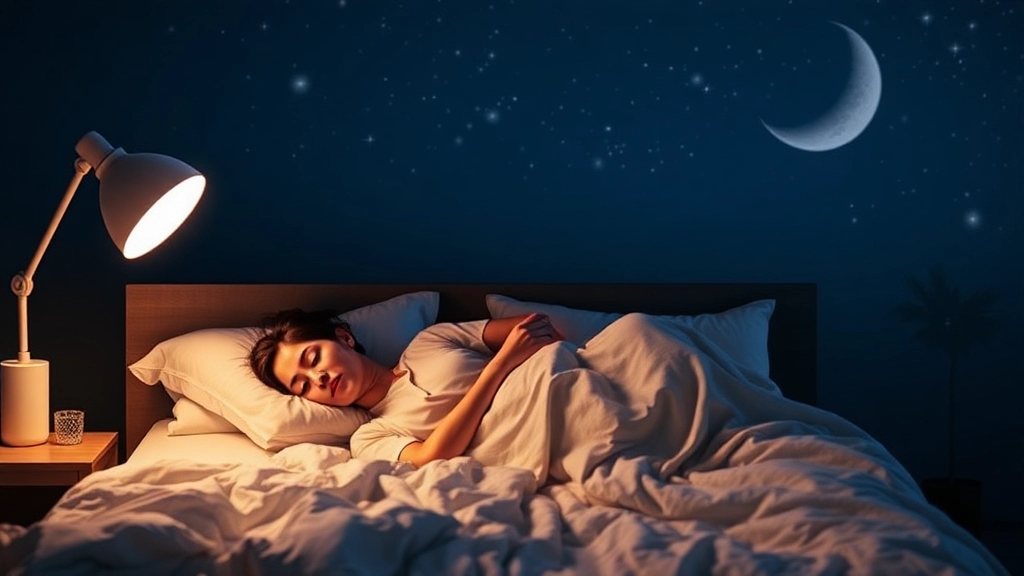
Alright, let’s talk about the holy grail of camping: sleeping comfortably.
Ever tried sleeping on the hard ground with a flimsy sleeping bag? Yeah, it’s the worst.
We’re about making your camping trip a dream, not a nightmare.
The Right Sleeping Bag
First up, the sleeping bag.
Get one that’s rated for summer temperatures.
Look for:
- Lightweight and breathable materials
- Mummy-style for warmth or rectangular for more space
- Compression sacks for easy packing
Sleeping Pads and Air Mattresses
Sleeping directly on the ground? Hard pass.
You need a sleeping pad or an air mattress.
Here’s why:
- Insulation from the cold ground
- Cushioning for your back
- Compact and easy to carry
Pillows Matter
Don’t skimp on a pillow.
A good pillow can make or break your sleep.
Options include:
- Inflatable pillows: Easy to pack
- Compressible pillows: More comfort, a bit bulkier
- DIY: Stuff a hoodie or bag with clothes
Blankets and Liners
Sometimes you need more than just a sleeping bag.
Consider:
- Fleece blankets for extra warmth
- Sleeping bag liners for added comfort and cleanliness
Real Talk: Why Comfort Matters
I once thought I could tough it out without all this gear.
Big mistake.
I woke up sore and grumpy.
Trust me, investing in these must-have sleeping items makes a world of difference.
Quick Tips for a Good Night’s Sleep
- Test your gear at home before the trip
- Set up your sleeping area early, while there’s still daylight
- Keep your sleeping bag dry and clean
What’s Next?
Got your sleeping gear sorted?
Great.
Now, let’s make sure you’ve got the right cooking equipment to fuel those epic adventures.
Check out our guide on Cooking Equipment and Food Storage Tips.
Cooking Equipment and Food Storage Tips
Alright, let’s dive straight into it. You’re heading out for a summer camping trip, and one of the biggest concerns on your mind is, “How do I cook my meals and keep my food fresh?” Trust me, I’ve been there. Nobody wants to end up with a soggy sandwich or a half-cooked meal. So let’s break it down.
Essential Cooking Equipment
First off, you need the right tools to cook your meals efficiently. Here’s a list of must-have cooking gear:
- Portable Stove: A compact, lightweight stove is a game-changer. Look for something easy to set up and fuel-efficient.
- Cookware Set: A basic set with a pot, pan, and kettle should cover most of your needs. Non-stick options are easier to clean.
- Utensils: Don’t forget a spatula, tongs, and a good knife. Trust me, you don’t want to be stuck trying to flip a pancake with a fork.
- Cooler: A reliable cooler is crucial for keeping your perishables fresh. Look for one with good insulation and ample space.
- Grill: If you love the smoky flavour, a portable grill is a fantastic addition. Just make sure it’s allowed at your campsite.
Food Storage Tips
Now, let’s talk about keeping your food safe and fresh. Here are some tried-and-true tips:
- Pre-Plan Meals: Organise your meals in advance. This helps in packing just the right amount of food and reduces waste.
- Separate Raw and Cooked: Use separate containers for raw and cooked foods to avoid cross-contamination.
- Use Ziplock Bags: These are great for storing snacks, marinating meats, and keeping your food organised.
- Freeze Before You Go: Freeze meats and other perishables before you leave. They’ll stay fresh longer and help keep your cooler cold.
- Keep Cool: Place ice packs at the bottom and top of your cooler. Store frequently used items on top for easy access.
Real Talk: Keeping It Fresh
Picture this: You’re halfway through your trip, and your cooler’s ice is melting. What now? Here’s a quick hack: use frozen water bottles instead of loose ice. They keep your food cold and double as drinking water when they melt.
Cooking Scenarios
Imagine you’re out in the wild, and it starts raining. No worries, mate. With a portable stove and a tarp, you can set up a quick cooking station. Or, if you’re at a campsite that allows open fires, nothing beats cooking your dinner over a crackling fire.
For more tips on making your summer camp experience enjoyable, check out our Summer Camping Top Tips & Gear Essentials and our Ultimate Packing Guide.
Sun Protection and Summer Apparel

Ever found yourself sunburnt and sweaty, wishing you’d packed better for your summer camping trip? Let’s sort that out.
Why Sun Protection is a Must
Summer camping is all fun and games until someone gets sunburnt.
Trust me, you don’t want to be that person.
Sunburn can ruin your trip faster than you can say “sunscreen.”
Essential Sun Protection Gear
Here’s what you need to keep those UV rays at bay:
- Sunscreen: Go for SPF 30 or higher. Reapply every two hours.
- Wide-brimmed Hat: Keeps the sun off your face and neck.
- Sunglasses: Protect your eyes from harmful UV rays. Polarised lenses are a plus.
- Lightweight, Long-Sleeved Shirts: Yes, even in the heat. They shield your skin without making you sweat buckets.
Summer Apparel That Works
You don’t want to be caught in the wrong gear. Comfort and protection are key.
- Moisture-Wicking Fabrics: Keeps you dry and cool.
- Breathable Footwear: Hiking boots or sandals, choose based on your adventure.
- Quick-Dry Shorts and Trousers: Because no one likes soggy bottoms.
- Layering Pieces: Evenings can get chilly. A light jacket or fleece can be a lifesaver.
Real Talk: My Camping Fail
Once, I forgot my hat.
Spent the whole day squinting and shielding my face with my hand.
Lesson learned: Always double-check your sun protection gear.
Pro Tips for Staying Cool
- Hydrate: Drink water regularly. Dehydration sneaks up on you.
- Seek Shade: Take breaks under trees or bring a portable canopy.
- Cooling Towels: Wet them and drape them around your neck. Instant relief.
Final Thoughts
Sun protection and the right summer apparel can make or break your camping experience.
Don’t skimp on this.
Pack smart, stay cool, and enjoy the great outdoors without the burn.
Got your sun protection sorted?
Great, now you’re ready to tackle the next challenge on your camping list.
Tools for Camp Setup and Repairs
Ever been stuck in the middle of nowhere with a tent that won’t stand or a broken camp chair? Yeah, me too. That’s why having the right tools for camp setup and repairs is non-negotiable. Here’s the lowdown on what you need to make sure your camping trip doesn’t turn into a survival show.
Essential Tools for Camp Setup
Setting up camp can be a breeze if you’ve got the right gear. Here’s what you should pack:
- Multi-tool: Think Swiss Army knife on steroids. It’s got pliers, screwdrivers, a knife, and more. Perfect for those unexpected fixes.
- Mallet: You’ll need this to hammer in tent stakes. Trust me, your hands will thank you.
- Tent Repair Kit: This usually includes patches, seam sealer, and extra stakes. Because a ripped tent in the middle of a storm? Not fun.
- Duct Tape: The universal fixer-upper. From patching holes to securing gear, duct tape is your best mate.
- Paracord: Strong, versatile, and can be used for everything from setting up a clothesline to securing your tent.
Must-Have Repair Tools
When things go south, you’ll want to be prepared. Here’s a list of repair tools you shouldn’t leave home without:
- Sewing Kit: For torn fabrics, a basic sewing kit can be a lifesaver. Needles, thread, and some safety pins can go a long way.
- Super Glue: Quick fixes for broken gear. It’s small but mighty.
- Zip Ties: These are great for quick fixes and securing loose items.
- Spare Parts: Bring extra tent stakes, pole segments, and other small parts that might break or get lost.
Real Talk: Why These Tools Matter
Imagine this: You’re setting up your tent, and one of the poles snaps. Without a repair kit, you’re either sleeping under the stars (not as romantic as it sounds when it’s raining) or heading home early. Or picture this: Your camp chair rips, and you’re stuck sitting on the ground. Not the end of the world, but not exactly comfortable either.
Pro Tips for a Smooth Setup
- Practice at Home: Set up your tent and other gear at home before you go. It’s easier to figure out what’s missing or broken when you’re not racing against sunset.
- Check Weather Conditions: Know what you’re up against. Windy? You’ll need extra stakes and stronger paracord. Rainy? Make sure your tent repair kit includes waterproof patches.
- Organize Your Tools: Keep everything in a small, clear bag so you can find what you need quickly.
For more on setting up your tent like a pro, check out our Ultimate Summer Camp Packing Checklist. And if you’re looking for fun activities to keep everyone entertained, our Summer Camp Scavenger Hunt Ideas guide has you covered.
First Aid and Emergency Kits
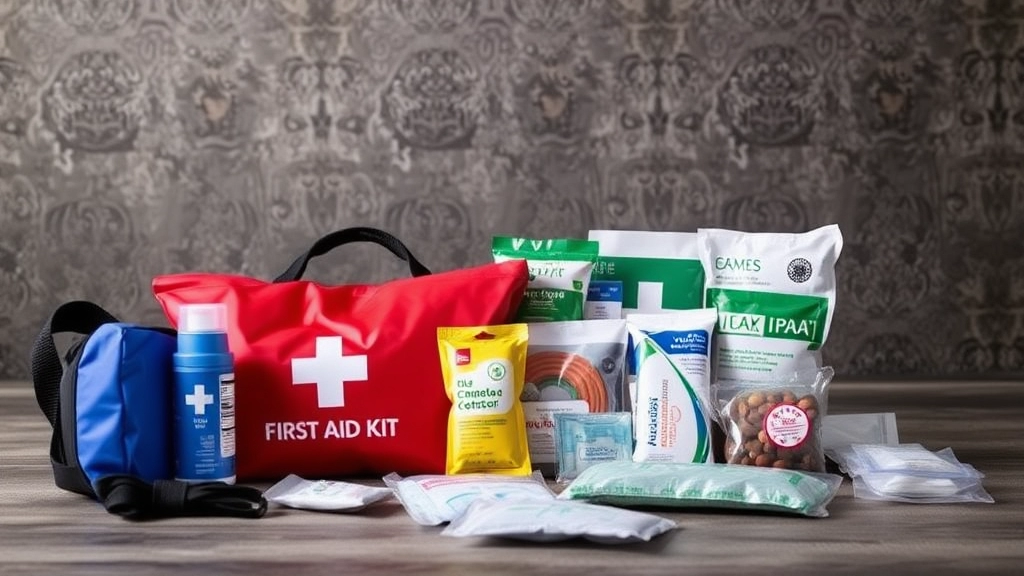
Ever been in the middle of nowhere and realised you’re missing a plaster?
Yeah, it’s a nightmare.
First aid and emergency kits are non-negotiable for any camping trip.
Why First Aid Kits are Essential
Cuts, scrapes, and bites are all part of the adventure.
But they can turn into a real hassle if you’re not prepared.
Having a well-stocked first aid kit can save your trip.
What to Include in Your First Aid Kit
You don’t need a full hospital setup, but you do need the basics.
Here’s what I always pack:
- Plasters and bandages: For those inevitable cuts and scrapes.
- Antiseptic wipes and ointments: To keep wounds clean.
- Pain relievers: Think paracetamol or ibuprofen.
- Tweezers: For splinters and ticks.
- Scissors: Handy for cutting bandages or clothing.
- Gauze pads and adhesive tape: For bigger wounds.
- Hydrocortisone cream: For rashes and insect bites.
- First aid manual: Just in case you need a quick refresher.
Emergency Kit Essentials
Beyond basic first aid, you need to be ready for bigger issues.
Here’s what I always have in my emergency kit:
- Multi-tool: Swiss Army knife or a Leatherman.
- Emergency blanket: Those silver foils can save lives.
- Whistle: For signalling if you’re lost.
- Torch and extra batteries: Because it gets dark out there.
- Fire starter: Matches, lighter, or a flint.
- Water purification tablets: In case you run out of clean water.
Personal Experience
I once sliced my hand on a rock while setting up camp.
No big deal, right?
But without my first aid kit, it could’ve ruined the trip.
A quick clean, a plaster, and I was back in action.
Internal Linking Opportunity
For more on staying safe, check out our section on Navigating Bug-Heavy Campsites.
Outdoor Entertainment and Recreation Gear
Alright, let’s dive right in. When you’re out camping, it’s not all about setting up tents and cooking over a fire. You need some outdoor entertainment and recreation gear to keep things lively and fun. Trust me, you don’t want to be stuck in the middle of nowhere with nothing to do. So, what should you bring along to ensure you have a blast? Let’s break it down.
Why Outdoor Entertainment Matters
Ever been on a camping trip where the most exciting thing was watching the fire burn? Yeah, not fun. Keeping everyone entertained is key to a memorable camping experience. Whether you’re with family, friends, or even solo, having the right gear can turn a good trip into a great one.
Must-Have Outdoor Entertainment Gear
- Portable Speakers: Music can set the mood. Whether you’re chilling by the campfire or hiking, a portable speaker can be a game-changer. Just make sure it’s waterproof and has a decent battery life.
- Board Games and Card Games: Perfect for winding down after a long day of activities. Compact, easy to pack, and great for all ages.
- Sports Equipment: Think frisbees, footballs, or even a badminton set. These can keep everyone active and entertained.
- Fishing Gear: If you’re near a lake or river, fishing can be both relaxing and rewarding. Don’t forget your fishing licence if required.
- Binoculars and Bird Guides: For the nature lovers, bird watching can be a fascinating way to spend your time.
- Books and E-Readers: Sometimes, you just want to relax with a good book. E-readers are great because they’re lightweight and can hold multiple books.
- Hiking Gear: Proper hiking boots, walking sticks, and a good backpack can make exploring the area more enjoyable.
- Outdoor Cameras: Capture your memories with a durable, waterproof camera. GoPros are a popular choice.
Keeping It Real: What I Pack
When I head out for a camping trip, I always make sure to pack a few essentials that keep everyone engaged. For example, last summer, I brought along a set of glow-in-the-dark bocce balls. Not only did it keep us entertained, but it also became a nightly ritual that everyone looked forward to.
Pro Tips for Outdoor Fun
- Plan Ahead: Know the activities available at your campsite. Are there hiking trails, lakes, or open fields? Plan your gear accordingly.
- Pack Light: Don’t overdo it. Choose versatile items that can serve multiple purposes.
- Stay Safe: Always prioritise safety, especially with sports equipment and outdoor activities. Helmets, life jackets, and first aid kits are non-negotiable.
For more ideas on keeping your camping trips exciting, check out our Top Summer Camp Games and Activities Guide and our Fun at Summer Camp: Top Activities and Choices for inspiration.
Water and Hydration Supplies
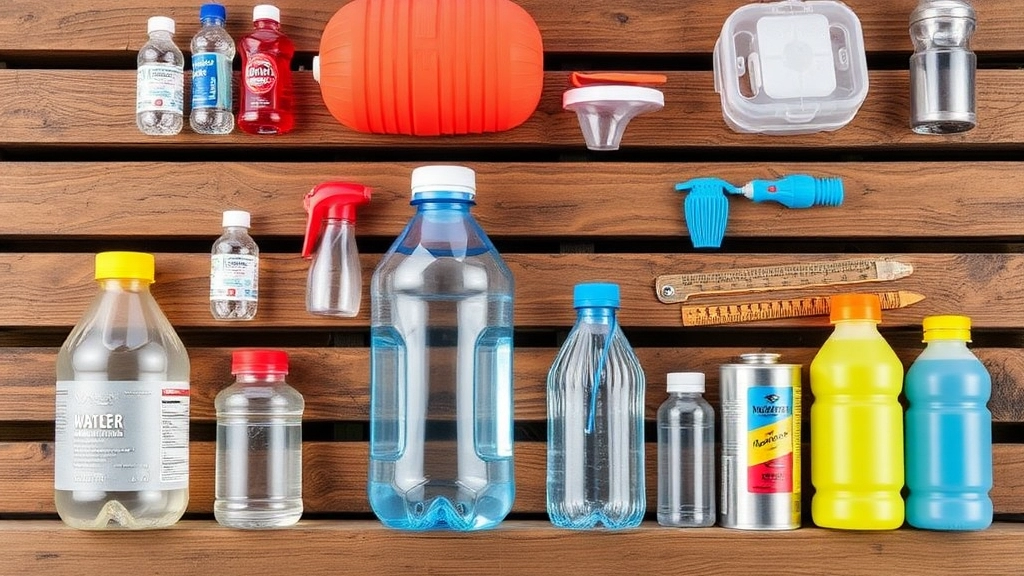
Ever found yourself parched and desperate for a drink while camping?
Yeah, me too.
Water and hydration supplies are crucial for any summer camping trip.
Getting this right can make or break your experience.
Why Hydration is Key
Summer camping means heat.
Heat means sweat.
Sweat means dehydration if you’re not careful.
Staying hydrated is not just about quenching thirst; it’s about keeping your body functioning.
Must-Have Water Gear
So, what do you need?
Let’s break it down:
- Reusable Water Bottles: Ditch the single-use plastic. Go for something durable and eco-friendly.
- Hydration Packs: These are lifesavers on long hikes. Carry water on your back and sip as you go.
- Water Filters/Purifiers: Natural water sources can be sketchy. A good filter ensures you’re drinking clean water.
- Collapsible Water Containers: Easy to pack and store, perfect for carrying extra water.
- Electrolyte Tablets: Not just for athletes. They help replace lost salts and minerals.
Water Storage Tips
You can’t just bring water; you’ve got to store it right.
Here’s how:
- Keep It Cool: Use insulated containers to keep your water cold.
- Avoid Direct Sunlight: Store water in the shade to prevent it from heating up.
- Regularly Refill: Don’t wait until you’re out. Refill whenever you can.
Real Talk: My Experience
Last summer, I hiked up a mountain without enough water.
Bad move.
Halfway up, I was lightheaded and exhausted.
A hydration pack would’ve saved me.
Quick Tips for Staying Hydrated
- Drink Regularly: Don’t wait until you’re thirsty.
- Monitor Urine Colour: Dark urine means you need more water.
- Eat Water-Rich Foods: Fruits like watermelon and oranges help too.
Navigating Bug-Heavy Campsites: Insect Repellents and Nets
Alright, let’s talk about something that can turn a great camping trip into a nightmareâbugs. Whether it’s mosquitoes, gnats, or other creepy crawlies, these pests can ruin your outdoor experience. So, how do you navigate bug-heavy campsites? Let’s dive into some practical, no-nonsense tips to keep those little nuisances at bay.
Why Insect Repellents and Nets Are Essential
First off, why even bother with insect repellents and nets? Well, if you’ve ever been eaten alive by mosquitoes or woken up with a spider in your tent, you already know the answer. Bugs can not only be annoying but also pose health risks like bites and diseases. So, having the right gear is crucial.
Types of Insect Repellents
There are a few different kinds of insect repellents, and each has its pros and cons. Here’s a quick rundown:
- Spray Repellents: These are easy to apply and cover a large area. Just spray it on your skin and clothes, and you’re good to go.
- Lotion Repellents: These are great for targeted application and tend to last longer on your skin.
- Wearable Repellents: Bracelets and clip-ons can be convenient, especially for kids, but they may not offer as much coverage.
Pro Tip: Look for products containing DEET or Picaridin for the best protection. If you prefer natural options, oils like citronella, eucalyptus, and lavender can work, but they might need more frequent reapplication.
The Importance of Bug Nets
Now, let’s talk about bug nets. These are a lifesaver, especially when you’re trying to sleep. Here’s what you need:
- Head Nets: Perfect for hiking or sitting around the campfire. They go over your hat and keep bugs away from your face.
- Tent Nets: Many tents come with built-in bug nets, but if yours doesn’t, invest in a good-quality one. Trust me, it’s worth it.
- Hammock Nets: If you’re a hammock camper, don’t forget a net. Bugs love to swarm around hammocks, and a net can make all the difference.
Setting Up Your Campsite for Bug Control
Location, location, location. Where you set up your campsite can make a huge difference in bug activity. Here are some tips:
- Avoid Stagnant Water: Bugs, especially mosquitoes, love stagnant water. Set up camp away from ponds, puddles, and slow-moving streams.
- Choose Open Areas: Bugs tend to congregate in dense vegetation. An open area with a bit of a breeze can help keep them away.
- Use a Campfire: Smoke from a campfire can act as a natural bug repellent. Just be mindful of fire safety rules.
Real-Life Example: My Bug Battle
Let me share a quick story. I once went camping near a lake, thinking it would be peaceful. Big mistake. The mosquitoes were relentless. I had a basic spray repellent, but it wasn’t cutting it. Luckily, I had a head net and a tent with a good bug net. Those saved the trip. Lesson learned: always over-prepare when it comes to bugs.
Quick Recap
To wrap it up, navigating bug-heavy campsites is all about preparation. Here’s a quick checklist:
- Spray, Lotion, or Wearable Repellent: Choose what works best for you.
- Head Nets, Tent Nets, Hammock Nets: Don’t skimp on these.
- Camp Location: Avoid stagnant water and dense vegetation.
- Campfire: Use it to your advantage.
Remember, the keyword here is “insect repellents and nets.” Make sure you have the right gear, and you’ll keep those bugs at bay, making your camping trip enjoyable and stress-free. Happy camping!
If you’re looking for more tips on how to make your camping experience enjoyable, check out our Summer Camping Outfit Essentials to stay cool and comfy. Also, for a comprehensive guide on what to pack, don’t miss our Summer Camp Packing List.
Optional Comfort Add-Ons: Furniture and Lighting
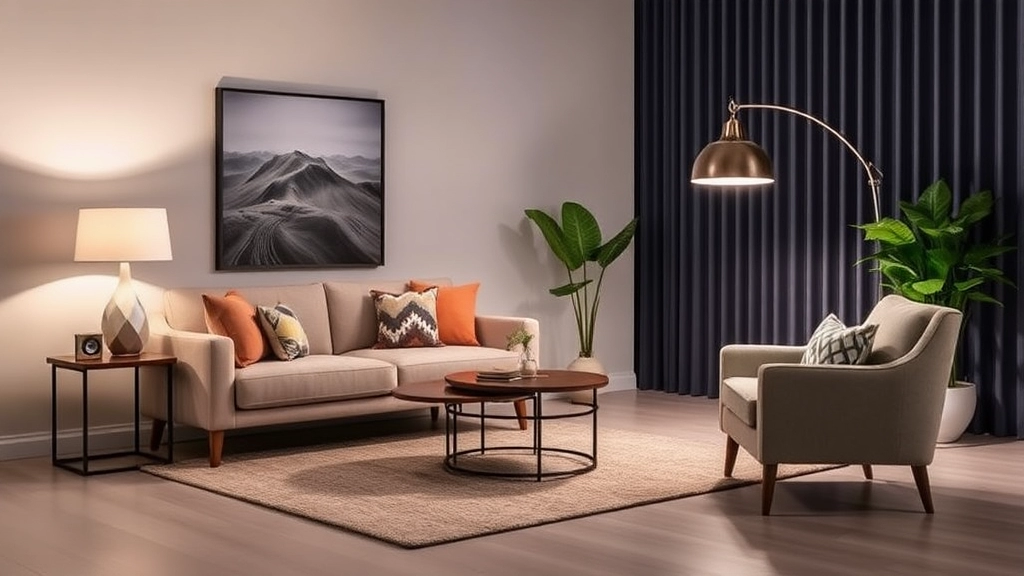
Ever found yourself wishing for a bit more comfort while camping?
Yeah, me too.
Camping doesn’t mean you have to rough it.
Let’s talk about comfort add-ons.
Why Bother with Extra Furniture?
Sitting on the ground can get old, fast.
Imagine this: You’ve set up your tent, cooked a nice meal, and now you want to relax.
But where?
A comfy chair or a portable table can make all the difference.
Here’s what I always pack:
- Camping Chairs: Lightweight, foldable, and easy to carry. Perfect for chilling by the campfire.
- Portable Tables: Handy for meals, games, or just keeping stuff off the ground.
- Hammocks: If you’re near trees, a hammock is a game-changer. Nap in style.
Lighting: Don’t Be Left in the Dark
Ever tried finding something in your tent at night without a light?
It’s a nightmare.
Proper lighting is essential.
Here’s the lowdown:
- Headlamps: Keep your hands free. Essential for late-night bathroom trips.
- Lanterns: Great for illuminating larger areas like your campsite or tent.
- String Lights: Add a cosy, festive vibe. Plus, they’re lightweight and packable.
Real Talk: What’s Worth the Space?
You might be thinking, “Do I really need all this?”
Fair question.
Here’s my take:
- Prioritise Comfort: If you’re camping for more than a night, these extras can make a huge difference.
- Pack Smart: Choose items that fold up small and are lightweight.
- Test at Home: Set up your gear in your garden before you go. Make sure it’s worth the space in your pack.
My Favourite Setup
Picture this:
After a day of hiking, you’re back at your campsite.
You set up your camping chair, crack open a cold drink, and hang some string lights around your tent.
You kick back, relax, and enjoy the evening.
That’s the kind of comfort I’m talking about.
Hygiene and Clean-Up Products for the Campsite
Alright, let’s get real for a second. When you’re out camping, hygiene and clean-up can be a make-or-break factor. Ever had a trip ruined by a lack of cleanliness? Yeah, me too. So, let’s dive into the essential hygiene and clean-up products you need to keep your campsite fresh and your sanity intact.
Why Hygiene Matters
First things first, why is hygiene so crucial when you’re camping? Simple. It keeps you healthy, comfortable, and happy. No one wants to deal with bug bites, infections, or just feeling grimy. So, let’s tackle the basics.
Essential Hygiene Products
Here’s your go-to list for keeping clean in the great outdoors:
- Biodegradable Soap: Regular soap can harm the environment. Go for biodegradable options to keep Mother Nature happy.
- Hand Sanitiser: Sometimes you can’t get to water. Hand sanitiser is your best friend in those moments.
- Wet Wipes: Perfect for a quick freshen-up when a shower isn’t an option.
- Toothbrush and Toothpaste: A no-brainer, but often forgotten. A fresh mouth can make you feel human again.
- Microfibre Towel: Dries quickly and takes up minimal space. Ideal for camping.
- Toilet Paper: Trust me, you don’t want to forget this. And pack it in a waterproof bag to keep it dry.
Clean-Up Gear
Keeping your campsite clean is just as important as personal hygiene. Here’s what you’ll need:
- Trash Bags: Pack it in, pack it out. Leave no trace behind.
- Portable Camping Sink: Makes washing dishes a breeze. Look for collapsible models to save space.
- Dish Soap (Biodegradable): Again, keep it eco-friendly.
- Scrub Brush: For those stubborn food particles on your cookware.
- Drying Rack: A compact, foldable one can save you a lot of hassle.
Real Talk: Practical Tips
Let’s break it down into some actionable tips:
- Create a Hygiene Station: Set up a designated area for washing hands, brushing teeth, and other hygiene tasks. It keeps things organised and makes it easier to maintain cleanliness.
- Routine is Key: Establish a daily routine for personal hygiene and campsite clean-up. It’ll become second nature and save you from chaos.
- Stay Organised: Use a caddy or a bag to keep all your hygiene products in one place. No more rummaging around in the dark for your toothbrush.
Stories from the Trail
I remember one camping trip where a friend forgot to pack wet wipes. By day three, he was practically begging to use mine. It’s those little things that can make a big difference. Another time, I didn’t bring enough trash bags and ended up with a messy campsite. Lesson learned: always overpack on clean-up supplies.
For more tips on organizing your campsite, check out our guide on campsite setup. If you’re looking for more camping gear recommendations, don’t miss our camping gear tips and fun activities.
Planning for Varying Summer Weather Conditions
Ever planned a camping trip only to be caught off guard by the weather?
Yeah, me too.
Summer weather can be a mixed bag, and if you’re not prepared, it can turn a fun trip into a miserable one.
Let’s break it down so you’re ready for anything Mother Nature throws at you.
Why Plan for Weather?
Summer weather is unpredictable.
One minute it’s sunny, the next it’s pouring rain.
Being prepared means you can enjoy your trip, no matter what.
Key Gear for Weather Preparedness
- Clothing Layers
- Base Layer: Moisture-wicking shirts and pants.
- Mid Layer: Insulating fleece or wool.
- Outer Layer: Waterproof jacket and trousers.
- Shelter
- Tent: Make sure it’s waterproof and has good ventilation.
- Tarp: Extra protection against rain and sun.
- Footwear
- Waterproof Boots: Essential for wet conditions.
- Sandals: Great for hot, dry days.
- Accessories
- Hat and Sunglasses: For sun protection.
- Gloves: For cooler evenings or unexpected cold fronts.
Weather Monitoring Tools
- Weather Apps: Keep an eye on the forecast.
- Portable Weather Radio: For updates when you’re off-grid.
- Thermometer: To monitor temperature changes.
Practical Tips for Different Weather
- Hot Weather:
- Hydrate: Drink plenty of water.
- Shade: Use tarps or natural shade.
- Timing: Plan activities for early morning or late afternoon.
- Rainy Weather:
- Stay Dry: Use waterproof gear.
- Elevate: Keep gear off the ground.
- Ventilation: Prevent condensation inside your tent.
- Cold Weather:
- Insulate: Use sleeping pads and warm sleeping bags.
- Layer Up: Wear multiple layers to trap heat.
- Hot Drinks: Keep warm with tea or hot chocolate.
Real Stories, Real Lessons
I remember one trip where the forecast was clear skies.
But, halfway through, a storm rolled in.
Our group was prepared with tarps and waterproof gear, so we stayed dry and enjoyed the rain from the comfort of our sheltered campsite.
FAQs on Summer Camping Checklist
What are the essential sleeping items for a comfortable camping trip?
To ensure a good night’s sleep while camping, you need a summer-rated sleeping bag, a sleeping pad or air mattress, a pillow, and possibly blankets and liners for extra warmth and comfort.
Why is sun protection important during summer camping?
Sun protection is crucial to avoid sunburn, which can ruin your camping experience. Essential items include sunscreen (SPF 30 or higher), a wide-brimmed hat, sunglasses, and lightweight, long-sleeved shirts.
What should be included in a camping first aid kit?
A well-stocked first aid kit should contain plasters, bandages, antiseptic wipes, pain relievers, tweezers, scissors, gauze pads, adhesive tape, hydrocortisone cream, and a first aid manual.
How can I stay hydrated during a summer camping trip?
Staying hydrated is essential. Bring reusable water bottles, hydration packs, water filters or purifiers, collapsible water containers, and electrolyte tablets. Store water in insulated containers and avoid direct sunlight.
What comfort add-ons can enhance my camping experience?
Comfort add-ons like camping chairs, portable tables, and hammocks can significantly improve your camping experience. Additionally, proper lighting such as headlamps, lanterns, and string lights is essential for nighttime activities.
What type of summer apparel should I pack for camping?
Pack moisture-wicking fabrics, breathable footwear, quick-dry shorts and trousers, and layering pieces like a light jacket or fleece for chilly evenings.
Why is it important to have an emergency kit while camping?
An emergency kit is essential for handling unexpected situations. It should include a multi-tool, emergency blanket, whistle, torch with extra batteries, fire starter, and water purification tablets.
How can I ensure my water supply is safe for drinking?
Use water filters or purifiers to treat natural water sources. Carry reusable water bottles and collapsible containers for extra water storage, and keep your water cool and out of direct sunlight.
What are some quick tips for a good night’s sleep while camping?
Test your gear at home, set up your sleeping area early, and keep your sleeping bag dry and clean. These tips will help you sleep better and enjoy your camping trip.
What should I do if I get sunburned while camping?
If you get sunburned, apply aloe vera or a soothing lotion to the affected area, stay hydrated, and seek shade. Wear protective clothing to prevent further sun exposure.
References
-
How to Choose a Backpacking Sleeping Bag
-
Best Camping Pillows of 2024
-
CDC – Heat Stress: How to Stay Cool

